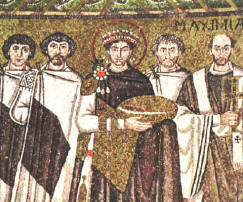Corpus Iuris Civilis

Mosaic of Justinian in San Vitale, Ravenna
Then Justinian ordered the codification of the legal opinions of the Roman jurists from ca. first century B.C. to the third century A.D. . On 15 December 530 he ordered a commission to work at it: sixteen lawyers from the legal fraternities of Constantinople and Beirut, men headed by Tribonian, who had already been a member of the commission that produced the Codex Justinianus. The result of their labor was published on 16 December, 533. It is the Digestum (Digest), or to give it its Greek name, the Pandects. At the same time, a committee also headed by Tribonian was working on a textbook for law students, the Institutes. It was published on 16 November. One byproduct of all this labor was to make the Codex vetus obsolete, and hence a new edition was published on 16 November, 534 and the first edition has failed to survive. This body of legal achievement has been known since the sixteenth century as the Corpus Iuris Civilis and it was intended as a unified body of law. In December 533 the commission also published the Institutes, which was a textbook to be used for first year students.
Justinian forbade
commentaries on the Digest and probably the rule applied to the whole
Corpus.
The last part of Justinian's
codification was the Novels They were new
laws that he issued after the Corpus was published.
The language of these constitutions was Greek.
He may have planned a collection
of his own legislation, but they were only put together as a collection until
after his death.